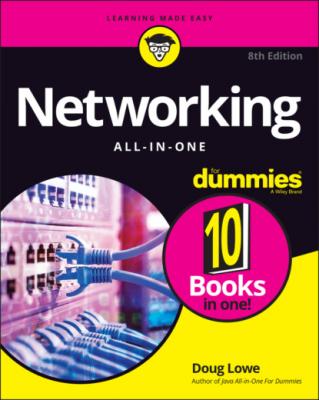Networking All-in-One For Dummies. Doug Lowe
Читать онлайн.| Название | Networking All-in-One For Dummies |
|---|---|
| Автор произведения | Doug Lowe |
| Жанр | Зарубежная компьютерная литература |
| Серия | |
| Издательство | Зарубежная компьютерная литература |
| Год выпуска | 0 |
| isbn | 9781119689058 |
16 Index
List of Tables
1 Book 1 Chapter 4TABLE 4-1 The Functions and Categories of the NIST Framework Core
2 Book 2 Chapter 1TABLE 1-1 The Seven Layers of the OSI Model
3 Book 2 Chapter 2TABLE 2-1 Maturity Levels for Internet Standards Track RFCs xxxTABLE 2-2 RFCs for Key Internet Standards
4 Book 2 Chapter 3TABLE 3-1 Powers of TwoTABLE 3-2 Logical Operations for Binary ValuesTABLE 3-3 IP Address ClassesTABLE 3-4 The Default Subnet MasksTABLE 3-5 Private Address SpacesTABLE 3-6 Well-Known Ports
5 Book 2 Chapter 6TABLE 6-1 The Original Seven Top-Level DomainsTABLE 6-2 The New Seven Top-Level DomainsTABLE 6-3 Geographic Top-Level Domains with More Than 200 SubdomainsTABLE 6-4 Location of the Hosts FileTABLE 6-5 The 13 Root ServersTABLE 6-6 Common Resource Record TypesTABLE 6-7 RDATA Fields for an SOA Record
6 Book 2 Chapter 7TABLE 7-1 nbtstat Command SwitchesTABLE 7-2 The Most Commonly Used nslookup Subcommands
7 Book 3 Chapter 2TABLE 2-1 ASA 5500-X Models
8 Book 3 Chapter 6TABLE 6-1 LTO Tape GenerationsTABLE 6-2 How Backup Types Use the Archive Bit
9 Book 4 Chapter 1TABLE 1-1 Twisted-Pair Cable CategoriesTABLE 1-2 Pin Connections for Twisted-Pair Cable
10 Book 4 Chapter 2TABLE 2-1 Common Default SSID Values
11 Book 6 Chapter 1TABLE 1-1 Minimum Hardware Requirements for Windows Server 2019 (Standard Editio...
12 Book 6 Chapter 4TABLE 4-1 Default Groups Located in the Builtin ContainerTABLE 4-2 Default Groups Located in the Users Container
13 Book 6 Chapter 5TABLE 5-1 File and Folder PermissionsTABLE 5-2 Special PermissionsTABLE 5-3 Special Shares
14 Book 6 Chapter 7TABLE 7-1 Environment VariablesTABLE 7-2 The Options Parameters
15 Book 6 Chapter 8TABLE 8-1 PowerShell Common Parameters
16 Book 7 Chapter 1TABLE 1-1 Small Business Plans for Microsoft 365TABLE 1-2 Enterprise Plans for Microsoft 365
17 Book 8 Chapter 2TABLE 2-1 Top-Level Directories in a Linux File SystemTABLE 2-2 Commands to Save and ExitTABLE 2-3 Commands for Moving the CursorTABLE 2-4 Commands for Inserting TextTABLE 2-5 Commands for Deleting TextTABLE 2-6 Commands for Changing TextTABLE 2-7 Commands for Yanking (Copying) and Putting (Pasting)TABLE 2-8 Other Commands
18 Book 8 Chapter 3TABLE 3-1 Linux Network Configuration Files
19 Book 8 Chapter 4TABLE 4-1 Common Resource Record Types
20 Book 8 Chapter 5TABLE 5-1 Commonly Used smbclient Commands
21 Book 8 Chapter 7TABLE 7-1 Mail Commands
22 Book 8 Chapter 8TABLE 8-1 Environment VariablesTABLE 8-2 Common Linux Services
23 Book 9 Chapter 1TABLE 1-1 TCP/IP Diagnostic Commands
24 Book 9 Chapter 2TABLE 2-1 Keyboard Shortcuts for Remote Desktop
25 Book 9 Chapter 4TABLE 4-1 Key Windows Services
26 Book 9 Chapter 5TABLE 5-1 Microsoft Volume License Plans
27 Book 10 Chapter 2TABLE 2-1 Some Well-Known TCP/IP Ports
List of Illustrations
1 Book 1 Chapter 1FIGURE 1-1: A typical network.FIGURE 1-2: A network with a wireless router and a switch.FIGURE 1-3: A network with a separate firewall router, switch, and WAP.
2 Book 1 Chapter 2FIGURE 2-1: Bus topology.FIGURE 2-2: Star topology.FIGURE 2-3: Ring topology.FIGURE 2-4: Mesh topology.
3 Book 1 Chapter 3FIGURE 3-1: A hub repeats all incoming data on all its ports.FIGURE 3-2: Unlike a hub, a switch knows where to send its data.FIGURE 3-3: Two IP networks connected by a router.FIGURE 3-4: Connecting offices with a VPN tunnel.
4 Book 1 Chapter 5FIGURE 5-1: Managing Active Directory Users and Computers.
5 Book 2 Chapter 7FIGURE 1-1: The Properties dialog box for a network adapter.FIGURE 1-2: Display the MAC address of a network adapter.FIGURE 1-3: Find network information from System Information.FIGURE 1-4: See TCP and UDP connections.FIGURE 1-5: How data travels through the seven layers.FIGURE 1-6: Ethernet and the OSI model.FIGURE 1-7: TCP/IP and the OSI model.
6 Book 2 Chapter 2FIGURE 2-1: The four layers of the TCP/IP framework.
7 Book 2 Chapter 3FIGURE 3-1: The Windows Calculator in Programmer mode.FIGURE 3-2: Octets and dotted-decimal notation.FIGURE 3-3: A network before and after subnetting.
8 Book 2 Chapter 4FIGURE 4-1: Connecting to the Internet via a residential gateway.FIGURE 4-2: Connecting a larger business network to the Internet.FIGURE 4-3: Connecting two networks via VPN.FIGURE 4-4: Using an internal router.
9 Book 2 Chapter 5FIGURE 5-1: The DHCP management console.FIGURE 5-2: The New Scope Wizard comes to life.FIGURE 5-3: The wizard asks for a name for the new scope.FIGURE 5-4: The wizard asks for scope information.FIGURE 5-5: Do you want to create exclusions?FIGURE 5-6: Set the lease duration.FIGURE 5-7: Provide the Default Gateway address.FIGURE 5-8: Provide additional DNS information.FIGURE 5-9: Viewing the address pool of a DHCP scope.FIGURE 5-10: The adapter’s Status dialog box.FIGURE 5-11: The adapter’s Properties dialog box.FIGURE 5-12: Enabling DHCP in the Internet Protocol Version 4 (TCP/IPv4) Proper...
10 Book 2 Chapter 6FIGURE 6-1: DNS names.FIGURE 6-2: DNS zones.FIGURE 6-3: The DNS Manager.FIGURE 6-4: The New Zone Wizard greets you.FIGURE
